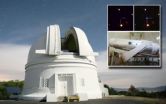(Press-News.org) The VLT Survey Telescope (VST) is the latest telescope to be added to ESO's Paranal Observatory in the Atacama Desert of northern Chile. It is housed in an enclosure immediately adjacent to the four VLT Unit Telescopes on the summit of Cerro Paranal under the pristine skies of one of the best observing sites on Earth. The VST is a wide-field survey telescope with a field of view twice as broad as the full Moon. It is the largest telescope in the world designed to exclusively survey the sky in visible light. Over the next few years the VST and its camera OmegaCAM will make several very detailed surveys of the southern sky. All survey data will be made public.
"I am very pleased to see the impressive first images from the VST and OmegaCAM. The unique combination of the VST and the VISTA infrared survey telescope will allow many interesting objects to be identified for more detailed follow-up observations with the powerful telescopes of the VLT," says Tim de Zeeuw, the ESO Director General.
"The VST project has overcome many difficulties but it is now repaying, with its excellent image quality, the expectations of the astronomical community and the efforts of the many people at INAF involved in its construction. I am very pleased to see the VST in operation," adds Tommaso Maccacaro, the President of the Italian National Institute for Astrophysics (INAF).
The VST programme is a joint venture between the INAF-Osservatorio Astronomico di Capodimonte, Naples, Italy [1] and ESO. INAF has designed and built the telescope with the collaboration of leading Italian industries and ESO is responsible for the enclosure and the civil engineering works at the site. OmegaCAM, the VST's camera, was designed and built by a consortium including institutes in the Netherlands, Germany and Italy [2] with major contributions from ESO. The new facility will be operated by ESO, which will also archive and distribute data from the telescope.
The VST is a state-of-the-art 2.6-metre aperture telescope with an active optics system to keep the mirrors perfectly positioned at all times. At its core, behind large lenses that ensure the best possible image quality [3], lies the 770 kg OmegaCAM camera, built around 32 CCD detectors [4], sealed in vacuum, that together create 268-megapixel images [5].
The First Images
Both the telescope and the camera have been designed to fully exploit the high quality skies at Paranal.
"The superb images now coming from VST and OmegaCAM are a tribute to the hard work of many groups around Europe over many years. We are now looking forward to a rich harvest of science and unexpected discoveries from the VST surveys," adds Massimo Capaccioli, principal investigator of the VST project.
The first released image shows the spectacular star-forming region Messier 17, also known as the Omega Nebula or the Swan Nebula, as it has never been seen before. This dramatic region of gas, dust and hot young stars lies in the heart of the Milky Way in the constellation of Sagittarius (The Archer). The VST field of view is so large that the entire nebula, including its fainter outer parts, is captured -- and retains its superb sharpness across the entire image.
The second released image may be the best portrait of the globular star cluster Omega Centauri ever made. This is the largest globular cluster in the sky, but the very wide field of view of VST and OmegaCAM can encompass even the faint outer regions of this spectacular object. This view, which includes about 300 000 stars, demonstrates the excellent resolution of VST.
The Surveys
The VST will make three public surveys over the next five years [6]. The KIDS survey will image several regions of the sky away from the Milky Way. It will further the study of dark matter, dark energy and galaxy evolution, and find many new galaxy clusters and high-redshift quasars. The VST ATLAS survey will cover a larger area of sky and focus on understanding dark energy and supporting more detailed studies using the VLT and other telescopes. The third survey, VPHAS+, will image the central plane of the Milky Way to map the structure of the Galactic disc and its star formation history. VPHAS+ will yield a catalogue of around 500 million objects and will discover many new examples of unusual stars at all stages of their evolution.
The data volume produced by OmegaCAM will be large. About 30 terabytes of raw data will be produced per year and will flow back into data centres in Europe for processing [7]. A novel and sophisticated software system has been developed at Groningen and Naples to handle the very large data flow. The end products from the processing will be huge lists of the objects found, as well as images, and these will be made available to astronomers worldwide for scientific analysis.
"The combination of large field of view, excellent image quality, and the very efficient operations scheme of the VST will produce an enormous wealth of information that will advance many fields of astrophysics," concludes Konrad Kuijken, head of the OmegaCAM consortium.
INFORMATION:
Notes
[1] The VST has been designed at the Astronomical Observatory of INAF at Capodimonte, Naples. All components apart from the main optics, which were supplied by the Russian firm LZOS, have been built by Italian industries. INAF has managed the construction and secured the assembly at the Paranal Observatory. This work was performed with the contribution of the project manager G. De Paris and the AIV manager D. Fierro, members of the INAF Department of National Projects, Monte Mario, Rome, Italy. The project manager of the current phase of commissioning is P. Schipani from INAF-Capodimonte Observatory. He was the former VST project engineer and leads a team mostly from the Naples and Padua Observatories. The VST-Tube software system to handle the data at Naples was developed by A. Grado.
[2] The OmegaCAM consortium is comprised of institutes in the Netherlands (NOVA, in particular the Kapteyn Institute / OmegaCEN Groningen and Leiden Observatory), Germany (in particular the university observatories of Munich, Gottingen and Bonn) and Italy (INAF, in particular the Padua and Naples Observatories). The ESO Optical Detector Team provides the detector system. OmegaCAM is headed by PI K. Kuijken (Groningen and Leiden University) and co-PI's R. Bender (Munich USM/MPE) and E. Cappellaro (INAF, Osservatorio Astronomico di Padova), project management is done by B. Muschielok and R. Hafner (University Observatory of the Ludwig-Maximilians University Munich) and the data handling system, Astro-WISE, is developed by OmegaCEN-NOVA led by E.A. Valentijn (Groningen).
[3] The telescope optics also include correction for dispersion by the Earth's atmosphere.
[4] The camera also contains extra CCDs, which work with the telescope's systems to help control the guiding and active optics systems.
[5] To measure the colours of objects in the sky, different very large glass filters can be slid automatically in front of the detectors. Each filter is over 30 cm on a side and most have special coatings that ensure that very little light is lost. There is also a very large shutter consisting of two blades that can be used to block the light while the detectors are read out.
[6] More details about the VST public surveys are available at http://www.eso.org/sci/observing/policies/PublicSurveys/sciencePublicSurveys.html.
[7] The VST/OmegaCAM surveys will make use of a new, dedicated fast intercontinental data link between Paranal and Europe that was established with support from the European Union (eso1043 - http://www.eso.org/public/news/eso1043/).
More information
ESO, the European Southern Observatory, is the foremost intergovernmental astronomy organisation in Europe and the world's most productive astronomical observatory. It is supported by 15 countries: Austria, Belgium, Brazil, the Czech Republic, Denmark, France, Finland, Germany, Italy, the Netherlands, Portugal, Spain, Sweden, Switzerland and the United Kingdom. ESO carries out an ambitious programme focused on the design, construction and operation of powerful ground-based observing facilities enabling astronomers to make important scientific discoveries. ESO also plays a leading role in promoting and organising cooperation in astronomical research. ESO operates three unique world-class observing sites in Chile: La Silla, Paranal and Chajnantor. At Paranal, ESO operates the Very Large Telescope, the world's most advanced visible-light astronomical observatory and two survey telescopes. VISTA works in the infrared and is the world's largest survey telescope and the VLT Survey Telescope is the largest telescope designed to exclusively survey the skies in visible light. ESO is the European partner of a revolutionary astronomical telescope ALMA, the largest astronomical project in existence. ESO is currently planning a 42-metre European Extremely Large optical/near-infrared Telescope, the E-ELT, which will become "the world's biggest eye on the sky".
Links
Photos of the VST: http://www.eso.org/public/images/archive/search/?category=1111&adv=&description=VST
Link to the ESO VST public web pages: http://www.eso.org/public/teles-instr/surveytelescopes/vst.html
Press release from the Georg-August Universität Göttingen: http://www.astro.physik.uni-goettingen.de/outreach/pr1106_omegacam.html
Contacts
Prof. Massimo Capaccioli
University of Naples Federico II and INAF-Capodimonte Astronomical Observatory
Naples, Italy
Tel: +39 081 557 5601
Cell: +39 335 677 6940
Email: capaccioli@na.infn.it
Prof. Koen Kuijken
Leiden Observatory
The Netherlands
Tel: +31 71 527 5848
Email: kuijken@strw.leidenuniv.nl
Prof. Edwin A. Valentijn
University of Groningen
The Netherlands
Tel: +31 50 363 4011/4036 (secretary)
Cell: +31 6 482 76416
Email: valentyn@astro.rug.nl
Prof. Ralf Bender
University Observatory of the Ludwig-Maximilians-University Munich, and Max-Planck-Institute for Extraterrestrial Physics
Garching bei München, Germany
Tel: +49 89 2180 5999
Email: bender@usm.lmu.de
Richard Hook
ESO, La Silla, Paranal, E-ELT and Survey Telescopes Public Information Officer
Garching bei München, Germany
Tel: +49 89 3200 6655
Cell: +49 151 1537 3591
Email: rhook@eso.org
First images from the VLT survey telescope
VST and 268 megapixel OmegaCAM start work
2011-06-09
ELSE PRESS RELEASES FROM THIS DATE:
Boden Wins Loyalty Award
2011-06-09
Boden, the multichannel retailer of apparel and accessories, emerged victorious as the CRM/Loylty category winner of Marketing Week's second Engage Awards. Announced at a glittering ceremony at the Grosvernor House Hotel in London, members of the Boden team were delighted by the recognition by judges and peers for their innovative CRM efforts.
The award-winning "Love Story" campaign featured personalised mailing, addressed to a customer's first name with a J Loves logo at the front. A fold-out spread was completely unique to each customer based on their shopping ...
Researchers solve membrane protein mystery
2011-06-09
MADISON – A University of Wisconsin-Madison research team has solved a 25-year mystery that may lead to better treatments for people with learning deficits and mental retardation.
Synaptophysin is the first protein and most abundant ever found on the membranes surrounding the tiny sacs that carry chemical messengers to synapses, the gaps where communication between nerve cells occurs. But even though the loss of synaptophysin has recently been linked to learning deficits and mental retardation, scientists have been unable for more than a quarter-century to explain what ...
Planet's soils are under threat warns University academic
2011-06-09
The planet's soils are under greater threat than ever before, at a time when we need to draw on their vital role to support life more than ever, warns an expert from the University of Sheffield today (9 June 2011) in the journal Nature.
Professor Steve Banwart from the University's Kroto Research Institute, will be helping to tackle this challenge as part of a new programme of international research, called Critical Zone Observatories (CZOs), funded initially by the USA National Science Foundation and the European Commission.
In some parts of the world, losses due ...
Boden Reaps Success With Innovative Catalogue Campaign
2011-06-09
Clothing retailer Boden reported a doubling of response on its latest enquirer conversion campaign in Summer 2011. Investment in an integrated multichannel approach to enquirer mailings with high level of personalisation paid off with improved ROI compared to past campaigns.
In May, Boden mailed Royal Wedding themed postcards to its enquirers, each featuring a personalised URL leading to a tailored micro site. Visitors were able to enter a competition to instantly win GBP1,000 worth of Boden clothing. Those that weren't lucky enough to scoop the prize were awarded with ...
Breast cancer drug pushes colon cancer cells to their death
2011-06-09
A new treatment for colon cancer that combines a chemotherapy agent approved to treat breast cancer and a cancer-fighting antibody is ready for clinical trials, according to Penn State College of Medicine researchers.
More than 150,000 cases of colorectal cancer are diagnosed each year, and about 50,000 people die from colorectal cancer yearly. Currently there are limited chemotherapy treatments for colorectal cancer with little that has been in the pipeline in recent years.
Wafik S. El-Deiry, M.D. Ph.D., American Cancer Society Research Professor and Rose Dunlap Professor ...
Water's surface not all wet
2011-06-09
Air and water meet over most of the earth's surface, but exactly where one ends and the other begins turns out to be a surprisingly subtle question.
A new study in Nature narrows the boundary to just one quarter of water molecules in the uppermost layer – those that happen to have one hydrogen atom in water and the other vibrating freely above.
Such molecules straddle gas and liquid phases, according to senior author Alexander Benderskii of the University of Southern California: The free hydrogen behaves like an atom in gas phase, while its twin below acts much like ...
Two Exciting Workshops Being Held in Conjunction With the 2011 STEMtech Conference
2011-06-09
The League for Innovation in the Community College has announced that two exciting workshops will be offered in conjunction with the 2011 STEMtech conference being held October 2-5, at the JW Marriott Indianapolis. Educators, industry leaders, and others will gather to discuss increasing student access into and success in science, technology, engineering, and mathematics (STEM) majors and careers. The 2011 STEMtech conference will also help educators explore the strategic use of information technology to better serve their students, campuses, and communities. Complete conference ...
Caltech-led astronomers find a new class of stellar explosions
2011-06-09
PASADENA, Calif.-They're bright and blue-and a bit strange. They're a new type of stellar explosion that was recently discovered by a team of astronomers led by the California Institute of Technology (Caltech). Among the most luminous in the cosmos, these new kinds of supernovae could help researchers better understand star formation, distant galaxies, and what the early universe might have been like.
"We're learning about a whole new class of supernovae that wasn't known before," says Robert Quimby, a Caltech postdoctoral scholar and the lead author on a paper to be ...
Einstein scientists find crucial molecule involved in spread of breast cancer
2011-06-09
June 8, 2011 — (Bronx, NY) — Researchers at Albert Einstein College of Medicine of Yeshiva University have identified a key player in the spread of breast cancer. The findings, published today in the online edition of Nature, identify a critical molecule that helps cancer spread beyond the primary tumor. The research highlights a potential new strategy against metastatic disease. The study's senior author is Jeffrey Pollard, Ph.D., professor of developmental and molecular biology and of obstetrics & gynecology and women's health at Einstein. He also holds the Louis Goldstein ...
New data adds to the hunt for dark matter in the universe
2011-06-09
This week it was announced that a dark matter detector about 700 meters below the ground in a Minnesota mine has recorded a seasonal modulation in staggeringly faint electrical pulses. One possible reason: this could be the result of dark matter particles called WIMPs that envelope the Milky Way galaxy and collide with atoms in the detector's germanium crystal.
This seems possible because the results are consistent with modulation in signals first recorded more than a decade ago by the DArk MAtter/Large sodium Iodide Bulk for RAre processes (DAMA/LIBRA) experiment at ...
LAST 30 PRESS RELEASES:
New deep-learning tool can tell if your salmon is wild or farmed
If you're over 60 and playing with sex toys, you're not alone
Fame itself may be critical factor in shortening singers’ lives
Daily coffee drinking may slow biological ageing of people with major mental illness
New highly efficient material turns motion into power – without toxic lead
The DEVILS in the details: New research reveals how the cosmic landscape impacts the galaxy lifecycle
After nearly 100 years, scientists may have detected dark matter
Gender imbalance hinders equitable environmental governance, say UN scientists
Six University of Tennessee faculty among world’s most highly cited researchers
A type of immune cell could hold a key to preventing scar tissue buildup in wounds
Mountains as water towers: New research highlights warming differences between high and low elevations
University of Tennessee secures $1 million NSF grant to build semiconductor workforce pipeline
Biochar shows powerful potential to build cleaner and more sustainable cities worldwide
UT Health San Antonio leads $4 million study on glucagon hormone’s role in diabetes, obesity
65-year-old framework challenged by modern research
AI tool helps visually impaired users ‘feel’ where objects are in real time
Collaborating minds think alike, processing information in similar ways in a shared task
Routine first trimester ultrasounds lead to earlier detection of fetal anomalies
Royal recognition for university’s dementia work
It’s a bird, it’s a drone, it’s both: AI tech monitors turkey behavior
Bormioli Luigi renews LionGlass deal with Penn State after successful trial run
Are developers prepared to control super-intelligent AI?
A step toward practical photonic quantum neural networks
Study identifies target for disease hyper progression after immunotherapy in kidney cancer
Concordia researchers identify key marker linking coronary artery disease to cognitive decline
HER2-targeted therapy shows promising results in rare bile duct cancers
Metabolic roots of memory loss
Clinical outcomes and in-hospital mortality rate following heart valve replacements at a tertiary-care hospital
Too sick to socialize: How the brain and immune system promote staying in bed
Seal milk more refined than breast milk
[Press-News.org] First images from the VLT survey telescopeVST and 268 megapixel OmegaCAM start work


